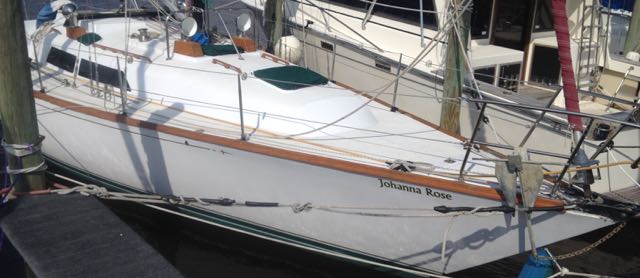The Old Deck
I purchase the Johanna Rose with her decks somewhat sanded for painting. In preparations for painting, all hardware was removed, the deck washed down with detergent, sanded with 80 grit, vacuumed, and washed down with Naphtha solvent.



Painting BrightSides
Since most of the deck area was to be non-skid, the area without non-skid were to be painted using Brightside white paint. Areas bare of paint were first primed with Interlux Prekote and sanded with 150 grit paper. Since the majority of the deck is non-skid, only the non-skid area and an overlap region was painted with Brightsides. After the first coat of Brightsides dried it was lightly sanded using grey 3M scotch pads followed by a Naphtha wipe down before applying a second coat of Brightsides. The coachroof was painted first followed by the foredeck.





Filling Old Instrument Holes
 |
| grinding fiberglass to a bevel |
The old Standard Horizon round instruments were non-functional, and so I decided to fiberglass over all of the old instrument in the coachroof. Each hole was ground down to the fiberglass, beveling the grind from full thickness to a near paper thin thickness over a two inch width. The procedure to fiberglass the hole followed closely the method describe by Don Casey in his "Complete Illustrated Sailboat Maintenance Manual". I used heavy, medium, light weight fiberglass weave. Cut large circles from the heavier weight material followed by slightly smaller circles of medium weight fiberglass patches, and so forth. I wetted out the material with epoxy and started layering with large fiberglass patches followed by smaller and smaller patches. Once the epoxy kicked and while the epoxy was still green, I faired over the area with 50-50 colloidal silica & 3M glass spheres. After curing and sanding, the area was ready for priming and painting.
 |
| curing epoxy |
 |
| fiberglass epoxy curing |
 |
finish sanding with spot putty, at a later time the instrument
below the compass was fiberglassed over too |
 |
| finishing with spot putty |
Finishing with KiwiGrip NonSkid

KiwiGrip is every thing that it is hyped up to be. Easy to work with. Does not require extensive prep or special primers. It is a bit on the expensive side, but I have learned that it is worth it. The bad issue I ran into was that it can be difficult to get during the cold months. This sounds crazy, but I was unable to get white KiwiGrip in Florida because the distributer is in the sate of Washington and they don't ship if there is a risk of it freezing! Apparently it spoils if frozen. They will overnight ship any time of the year, but I was not interested in paying an additional $90 for shipping.
Eventually I was able have some white KiwiGrip shipped out of Los Osos, CA by Chetco Marine in mid March. By the time I finished, I ended up using about 1.25 gallons of KiwiGrip. It turned out that the first gallon of KiwiGrip from Chetco Marine arrived damaged and opened in the box. I managed to salvaged about 1/2 the gallon. Chetco Marine(nice folks) sent out a complete replacement gallon. I still have a little left for touch ups. One gallon may have been enough, but since I had plenty, focused on putting down a good layer.
KiwiGrip goes on easy. Basically you just thickly slop it on the surface. I used a paint brush. It's like coating your deck with a thick layer of mayo. You then go over this with the KiwiGrip proprietary roller (which is the same as a Rust-Oleum Restore roller found at Lowes). That's it.
Below are photos showing results of the deck painting. The final section painted was the cockpit which was actually done at the dock. In the photos below, the cockpit locker lid remain unpainted but soon have a Brigthtside paint base with a standard non-skid of Kiwigrip matching the rest of the cockpit.








 |
| locker tops are not painted in this photo |
 |
| old round instruments holes are gone |











































